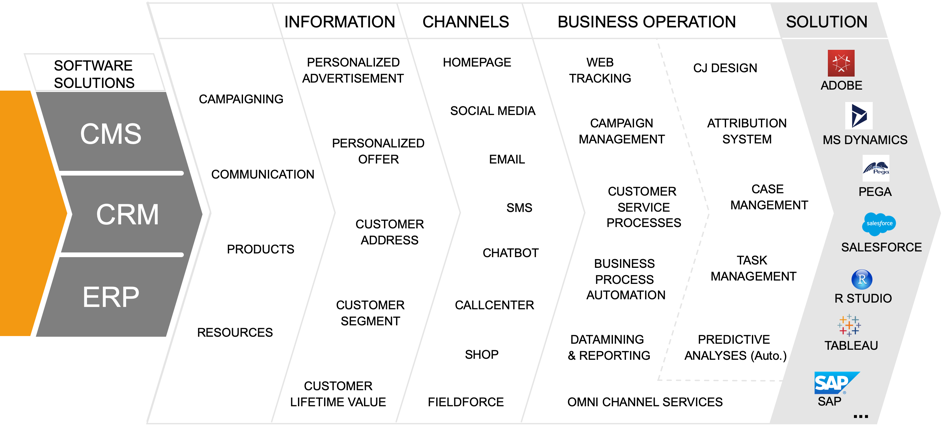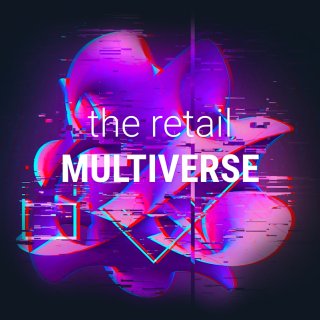
make your crm rollout a success
the crm rollout works with the right planning
An increase in customer loyalty of just five percent already yields an average profit growth of 50%, in some industries even up to 95% (source Bain & Company). So let’s focus on encouraging customer loyalty by establishing excellent customer relationships. In other words, the customer should come first, and CRM systems create the prerequisites that make this possible. They help establish stronger customer relationships, make faster and more informed decisions, and thereby ensure more effective sales overall.
CRM strategies are crucial to the success of the companies’ competitiveness. However, companies often encounter obstacles when they first introduce a CRM system or want to modernize an existing system. In our two-part “Insights” series on rolling out a CRM system, we would like to show you which stumbling blocks you should avoid in the planning and implementation phases to ensure that your CRM rollout runs smoothly.
1. What scope should the system cover?
As part of the corporate strategy, the customer experience strategy is the foundation of customer relationship management. In order to derive the objective of the CRM system, companies need to find answers to the question of how they want to interact with their customers in the future. In other words, they need a strategy-based derivation of ideal customer journeys. Consequently, this also reveals which system functions offer added value to the company and its users of the CRM system.
In short, you should be able to answer the following questions at the start of the planning phase:
- How does the company envision its customer interactions in the future? Which industry-specific trends should be taken into account?
- Which functionalities does the end user need to be able to perform in order to meet the strategic goals of customer interaction?
- How is sales management to be covered in the new system, and how can success be measured?
This ensures that the operation methods and steps of the end users are taken into account on the one hand and that the CRM system follows the corporate strategy on the other hand.
2. Which KPIs are used to measure the success of the CRM system implementation?
For the motivation and performance drive of employees, balanced scorecards are often linked to rigid corporate goals, such as the number of rollouts in different markets or business divisions. However, such goals are usually incompatible with the dynamic circumstances of a rollout, and the quality of the system suffers as a result. A purely quantitative view of the rollout’s success will not lead to sustainable and value-generating use of the CRM system.
Therefore, defining KPIs in advance is a critical success factor: They must not lead to unrealistic scheduling of the rollout, but should put the focus on the quality of the system and its successful long-term use. Top priority of the rollout is to enable a sustainable and efficient use of the new system in order to maintain customer relationships in the best possible way.
Of course, the consideration of the ROI also plays an important role in customer-oriented projects in the long term. However, focusing only on short-term revenue or ROI will not be compatible with a customer-centric strategy. Instead, we recommend focusing more on the long-term and qualitative return in order to achieve efficient system usage and end customer satisfaction. Relevant indicators for this include the system utilization rate, the end users’ satisfaction, and the long-term customer satisfaction (e.g. measured using the NPS score). The customer relationship can be regarded as an investment project, so the ultimate goal should always be to fully exploit the customer value potential. This goal can also be determined in a quantitative fashion (e.g. with rpc’s customer value cube) and should be part of measuring the success of each and every CRM system implementation.
However, the KPIs are often not determined by the project teams, but have been firmly established throughout the entire company for years. This is why it is particularly important to shift the definition of the KPIs away from rigid quantitative specifications and towards more qualitative KPIs, and to anchor this definition at management level. A change of the mindset in the company is therefore necessary. Depending on the corporate strategy and the size of the company, various change management measures help to make the new KPIs easier to understand, to determine them jointly at project level, and consequently to establish them successfully in the company.
3. How is the rollout managed?
For the rollout, it should be ensured that project steering and possibly even the first project management tools are determined prior to the start of the project. The aim is to clearly define both the methodology of the procedure as well as the roles and responsibilities and to generate a common understanding among all members of the team. We generally recommend following an agile approach, as this, for example, allows to continuously incorporate user and customer feedback into the development and implementation of the CRM system. However, there are also certain areas of software development in which it is recommended to use the “waterfall” approach. A good example here are integrations into complex system landscapes, which often require a high degree of interface coordination. This may also turn out to be an efficient approach if the company’s requirements and goals are already fixed from the very beginning.
However, obstacles arise regardless of the chosen rollout methodology. In light of our extensive experience with agile rollout projects, we would like to point out a number of pitfalls that often stand in the way of a successful agile rollout:
A lack of understanding of the role of the product owner
The task of the product owner in an agile SCRUM project is to determine the needs and requirements of the stakeholders involved and to take responsibility for the product vision with regards to time and budget. The project owner is not involved in programming – this is the task of the development team. If this understanding of the role is not made clear to the responsible product owner, the project team, and the stakeholders, a conflict of interest will arise and the product owner will be pulled in different directions.
A lack of methodological knowledge and outdated hierarchical thinking
Agile rules are often not adhered to because the methodology of the project is unknown. This leads to inefficiency and frustration within the project team. If the management has an awareness for cultural change, or, in other words, if it has developed a sense for agile management, an important foundation for adhering to the rules of the game has already been laid. Should managers fall back into their old hierarchical patterns, for example by giving top-down instructions and seizing control of the implementation, the SCRUM master, as an integral part of the team, can intervene to prevent the product owner from being pulled in different directions. Other colleagues from the management team can also catch the runaways and get cross-company support from an agile coach, for example.
4. When and how to integrate which stakeholders?
Too many cooks spoil the broth – the same applies to a CRM rollout. A well balanced team with members from all relevant stakeholder groups is essential to ensure that not only the corporate strategy, but also the customers’ needs and the methods of the various users are taken into account when programming the new system.
The selection of stakeholders should be well thought out. It does not make much sense to involve all conceivable stakeholders in all aspects of the implementation and rollout right from the start. Instead, we recommend performing an analysis of customer needs as well as a targeted as-is analysis within the end user area at the beginning of the project. The as-is analysis should be performed on a small scale, with just one representative from each of the relevant areas, and should then be continuously monitored and updated through an iterative process. The goal here is to understand the needs and methods of operation.
At this point, targeted expectations management of the stakeholders is important in order to avoid that various expectations regarding the implementation of functionalities already exist. The specific requirements are then defined in a further step, and the stakeholders are involved successively. The system thus undergoes evolutionary development when small, effective uses case are processed. After the implementation of the system, the desired usability should be established and, as a consequence, ensure acceptance of the new system.
5. How to choose the right system?
Different manufacturers have also prepared for various CRM strategies and corporate structures. As a result, we have a huge selection of CRM systems with various functionalities. The challenge now is to find the most appropriate system for the company. Aside from technical aspects, such as the scope of integration and technologies (on premises vs. cloud), there are numerous business aspects to be taken into account. A fundamental decision factor should always be the structures of the company, such as the sales structures in wholesale and retail or the focus on B2C or B2B.
Thus, aside from the size of the company and the number of users, a crucial factor is that the architectural hierarchy chosen by the company can be mapped within the selected system. If this is not taken into account, setting up the system will involve additional workarounds and increased effort. Our experience with various system providers and different evaluation aspects has allowed us to draw up some comparisons and evaluation methods that make it easier for our clients to decide on a suitable CRM system.
Figure 1: Example of a selection matrix for a CRM system; source rpc
But no matter what you decide to do, please avoid making one of the biggest mistakes when implementing a new CRM system right at the start: Instead of questioning existing processes, the old system environment is often transferred to a new system and enriched with a couple of new functionalities. This will certainly not help you to achieve a breakthrough in customer relationship management. We recommend evaluating the standard processes of the new system to determine which of the processes and functionalities really make sense for the company. The leading CRM system providers have extensive experience in standardization and often offer an adequate basis for efficient process definition while at the same time taking trends and state-of-the-art solutions into account. Therefore, try to find a good compromise between a CRM system that can be adapted to your processes and one that helps you establish more innovative processes.
We will be happy to provide you with in-depth insights into our experience. In the second part of “Know the pitfalls and make your CRM rollout a success – from planning to sustainable implementation,” you will find out which other aspects you should pay attention to in the further course of preparation and implementation.
Here you can find further articles that might be interesting for you:
“With data analysis to an individual customer experience”
“Customer centricity and journey design – the customer at the heart of everything”
“Agile methods and customer centricity – first steps to successful transformation”
“Why emotionally connected customers are more valuable than just satisfied customers”
“Success with CRM – the most important factors for your customer relationship management”










